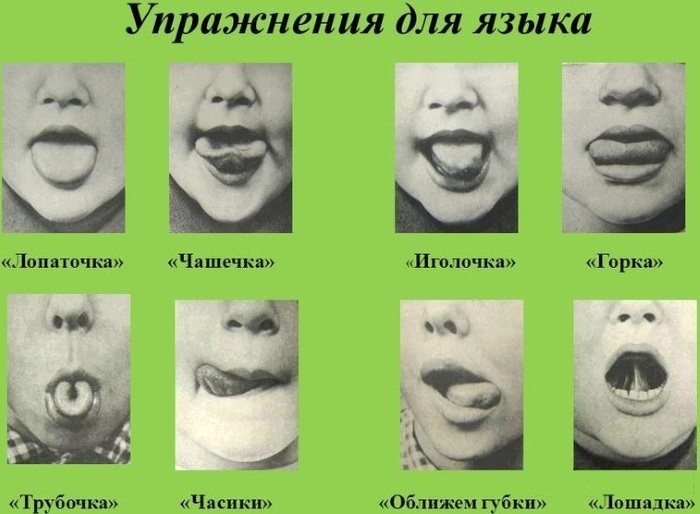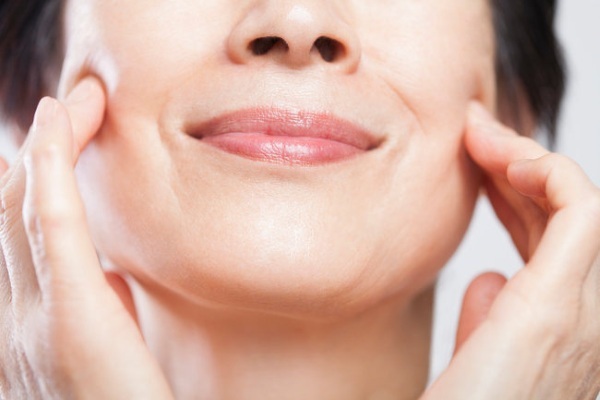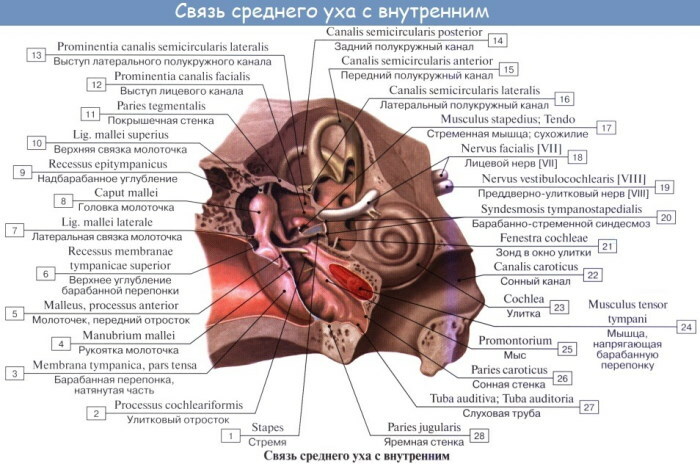Content
- Exercise after a stroke
- Lip development
- Language development
- Gymnastics to improve the functions of the facial muscles
- Complex for voice restoration
- Gymnastics for facial expressions
- Other techniques
- Exercises after dental prosthetics
- Complex for language
- Tongue Twisters
- Exercises to warm up the facial muscles and accelerate blood microcirculation
- Voice training exercises
- Video about exercises for the development of the river
Exercises for the development of speech help to develop the correct pronunciation of all sounds in young children. But for adults, a special complex has also been developed with which you can restore speech after a stroke or dental prosthetics.
Speech after a stroke may never recover, so exercises have been developed that help a person return to a full life. After prosthetics, there is a partial violation of the pronunciation of certain sounds, which makes the person complete and nervous. But there is a way out, by performing simple exercises every day, you can restore speech functions that have been impaired due to a stroke or prosthetics.
Exercise after a stroke
Speech development exercises in adults who have had a stroke will not completely restore the impaired speech, but it is possible to improve the pronunciation of words. Initially, you can invite a speech therapist home, who will help you develop a training program correctly and give the necessary recommendations. Only persistent daily training for 15-20 minutes will give real results.
Exercises for developing speech in adults after a stroke begin with simple reading aloud, such as children's poetry. All words must be pronounced clearly and distinctly, without haste. The first few weeks will be enough for 10 minutes. read, and then the class time is increased and a gymnastic complex consisting of such exercises is added.
Lip development
A stroke provokes numbness and paralysis of some parts of the body, the lip is also often affected. It is because of their limited mobility that it is not possible to normalize speech.
To develop lips, you need to perform the following exercises:
- stretch your lips as far as possible, folding them into a tube;
- grab one lip with the other and vice versa;
- using your fingers to pull your lips up, down, to the sides;
- a wide smile that needs to be alternated with other grimaces: a sad expression, drooping the corners of the lips downward.
Make faces and develop lips every day for 5 minutes.
Language development
Together with the lips, you need to develop the language in order to pronounce sounds and words more clearly.
The following training is suitable for developing a language:
- stick out your tongue as far as possible;
- alternately, you need to touch the sky with the tongue, and then the bed in the area under the tongue;
- lick your lips in a circle, periodically changing direction;
- round off the tongue, leading it as far as possible;
- move the tongue, heading along the inner surface of the cheeks and lips up, down, to the sides.
Gymnastics to improve the functions of the facial muscles
A simple complex that can be done in any comfortable position, sitting or lying down, will help improve articulation and muscle work in the facial area.
It is better to perform it before speech therapy exercises:
- stretch your lips with a tube and make a lingering sound "U";
- do not bite hard on each of the lips;
- smile, but do it so that the symmetry of the corners of the lips is preserved;
- roll the tongue into a tube;
- smack your lips;
- slowly inflate, and then deflate the cheeks.
Complex for voice restoration
This complex includes such simple actions:
- take turns to pronounce each vowel as clearly as possible;
- perform movements as when pronouncing the sound "Y", but only to yourself;
- pronounce each vowel, but only put stress in different places;
- pronounce all consonants in turn, but first all are voiceless, and then voiced.
Gymnastics for facial expressions
If you perform all the recommended exercises in combination, then you can achieve significant results.
Be sure to add mimic gymnastics to the complexes described above:
- frown eyebrows, raise them in surprise, lower them and relax;

- open your mouth wide, and then relax it;
- fold your lips as if you are going to kiss someone;
- perform jaw movements.
Other techniques
In addition to gymnastic exercises, good results have been observed in stroke patients using alternative therapies. The table below shows the most successful of them.
| Physiotherapy | Electrical impulses help to develop and stimulate the facial muscles. If you supplement them with massage, you can significantly improve speech. |
| Acupuncture | This procedure is prescribed to restore speech in motor aphasia. |
| Music therapy | In some cases, a stroke completely takes away speech, and the patient cannot even pronounce individual words, but sings beautifully. In this case, all lessons are conducted in the form of singing. |
Also, good results in the restoration of speech are given by decoctions of medicinal herbs. Sage decoction is especially recommended. It is taken 4 sips up to 5 times a day.
You should do it daily. The complex is so simple that it can be performed in any convenient place and in any position. It is enough to spend only 20-30 minutes. a day to return speech and start living a full life again, communicating with family and friends.
Exercises after dental prosthetics
A removable denture is the only way to restore the dentition if it has been lost as a result of trauma or old age. But many patients, after installing the prosthesis, begin to lisp or not clearly pronounce the words.
When diction is disturbed after the placement of the prosthesis, many patients become confused. Often with such a problem, people become silent. But as experts say, this cannot be done, the problem must be solved and for this there are a lot of simple and accessible methods.
Language exercises aimed at developing speech in adults will help you regain the clear pronunciation of words after the prosthesis is installed. It will be enough to allocate 15 minutes. up to 4 times a day to say a few tongue twisters, read expressively poems or books aloud.
Good results are obtained by clearly pronouncing such words: good, arch, wasp, rainbow, rose. To begin to pronounce the words, you must first slowly, in a whisper and with pronounced articulation. Gradually you need to strengthen your voice. Other gymnastic complexes can also be used.
Complex for language
Performing such gymnastics should be in front of a mirror to observe how the tongue and lips work.
You need to start your workout with the following exercises:
- Pronounce vowel sounds alternately: A, E, I, O, U and Y. See if the lips are stretched into a tube while pronouncing the sound "U". But while pronouncing "A" the mouth should be rounded. If, during the pronunciation of sounds, the lips did not give out the desired shape, then exercises for the development of articulation will also need to be added to daily exercises.

- Be sure to check how mobile the language is. Looking in the mirror, roll your tongue up. Try to stick your tongue out of your mouth and try to make it thin like a snake. Try to reach the tip of your tongue to your nose.
- Diagnose how actively the lower jaw is working. It is necessary to open your mouth as much as possible, try to insert your palm between your teeth, but without your thumb. Few people manage to perform this exercise correctly, which means only one thing, that there are problems with articulation.
Tongue Twisters
By pronouncing tongue twisters, you can clearly develop diction and train various groups of consonants.
Below is a set of tongue twisters that will help you develop your speech correctly and harmoniously:
- In Kabardino-Balkaria, Valokordin is from Bulgaria.
- The inauguration passed with a bang for the guru.
- On the screw, you see, the views of the well-worn Winda are visible.
- The exquisite ligature is very influenced by the word.
- By chance, a child was conceived before the wedding.
It is also important to know how to pronounce tongue twisters correctly. Many people, pronouncing a tongue twister, often stumble, stop and start all over again. They stumble again in the same place and start over again. But this is not the right training. It is necessary not to stop and not start over, it will be correct to say the word that you stumbled on several times. Then repeat the patter again completely.
It is better not to use complex tongue twisters right away, since articulation is broken and not yet strengthened. To develop it better, you need to start your workout with a warm-up, then stretching the articulators and ensuring a rush of blood.
Exercises to warm up the facial muscles and accelerate blood microcirculation
Exercises for the development of speech in adults who have undergone the prosthetics procedure involve preparing and warming up the muscles in the lip area.
The complex includes such manipulations:
- having closed your lips, massage the tip of your gum tongue, starting from the right and moving to the left, and so repeat 4-5 times;
- with the tip of your tongue, draw circles on the lips, 4 times in one direction and in the other;

- depict a "whirlpool", for this you need to gently slide the inside of the lips over the teeth, starting from the position in which the sound "U" is pronounced and heading towards the position inherent in the pronunciation of the sound "BUT".
After this complex, a person will definitely feel that the facial muscles are tired. To relieve tension, you need to exhale, so much so that your lips vibrate. The sound should resemble a snorting horse.
Next, you need to start developing the mobility of the language:
- stick out your tongue and slightly bite it, starting from the tip and moving to the root, repeat up to 8 times;
- then you need to chew your tongue with your lateral teeth;
- poke the tip of your tongue into one, and then into the other cheek, first you need to stay in the extreme position for a count of 4-5, and then gradually accelerate the movement, as far as it will turn out, at the end you need to perform two injections at once into one cheek.
Next, you need to start developing the jaw muscles:
- without any jerks, start moving the jaw from one side to the other as smoothly as possible and repeat this manipulation up to 5 times;
- protrude the lower jaw forward, and then hide it under the upper jaw up to 8 times;
- the lower jaw should be pulled down as low as possible, fixed in the lower position with your hands and try to close your mouth, like stretching brings discomfort, so initially you need to spend no more than 6 seconds on it, and then gradually time increase.
Voice training exercises
Exercises for the development of speech in adults after the placement of a removable denture. Often, due to the fact that a person does not pronounce the words familiar to him, he simply falls silent or his speech resembles a whisper. Even when a person, after training, regains intelligibility to his words, he still continues to speak quietly, in this case, additional include 3 exercises in your workout to help develop your voice:
- Pronounce vowel sounds. The vowels should be repeated alternately and this should be done until there is enough breath. During the pronunciation of "a", "o", "u", you can make your voice more sonorous. Workouts should be done daily, even a few days off can nullify all efforts.
- Activation of the muscles of the abdomen and chest. Pronounce the sound "m", but the mouth should be closed. The first pronunciation should be quiet, and then it is as if you add sound, straining the vocal cords to the maximum.
- Pronounce words that include the sound "r". You just need to start a workout with a growl, and then pronounce the words, but the letter "r" should stand out strongly against the background of others.

Books that should be read only aloud, clearly pronouncing each word, also help to develop the voice.
To regain diction, it is important to practice daily. After 2 weeks of regular training, you can see real results. It is definitely worth remembering that laziness will not be beneficial, but on the contrary will nullify all previously obtained results. Practice for half an hour every day, and no one around you will say that the speech has changed.
They begin to develop diction from an early age. If a person does not speak well all his life, then speech disorders after a stroke and prosthetics do not bring him much excitement. But people with a well-developed speech have a difficult time.
Special exercises will help you return to your usual life, return clear speech and pronunciation of individual words. In addition, reading aloud, pronouncing tongue twisters is useful for adults who have suffered a stroke, because the brain is actively working, and all disturbances in its function are quickly restored, memory is stimulated.
Video about exercises for the development of the river
Articulation. Best diction exercises:



